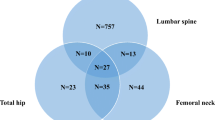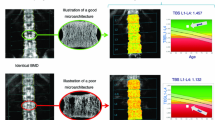Abstract
We performed a cross-sectional study to investigate the prevalence of Diffuse Idiopathic Skeletal Hyperostosis (DISH) through Dual-Energy X-ray absorptiometry (DXA) Vertebral Fracture Assessment (VFA) in a group of post-menopausal women with Type 2 Diabetes Mellitus (T2DM). We also explored several biomarkers of bone turnover metabolism, including Wnt pathway modulators. DXA-VFA was performed to detect the presence of DISH. Serum samples were collected from all patients at the time of study recruitment. 16 different serum biomarkers were tested between the two subgroups. Given the exploratory nature of the study, we did not adjust for multiplicity. At VFA analysis, among 96 individuals enrolled in the study 20 (20.8%) showed features of DISH. No statistically significant difference was found for BMD values, between the DISH and NO-DISH subgroups. Concerning blood biomarkers, DISH patients showed a significant difference only in the sclerostin serum levels (32 vs 35.5 pmol/L, for the DISH and NO-DISH subgroup, respectively; p = 0.010). After adjustment for confounding factors, sclerostin serum levels remained significantly lower in DISH group (p = 0.002). We demonstrated a non-negligible prevalence of DISH in a population of post-menopausal women affected by T2DM and suggested low serum sclerostin as a possible key feature associated with DISH presence. In addition, we propose DXA-VFA analysis, whose radiation dose is considerably lower than conventional radiography, as a viable diagnostic and prognostic mean to obtain data not only on bone health, but also for the screening for DISH in subjects at risk.




Similar content being viewed by others
Availability of Data and Materials
The dataset used and/or analyzed during the current study are available from the corresponding author on reasonable request.
Abbreviations
- SD:
-
Standard deviation
- BMI:
-
Body mass index
- HbA1c:
-
Glycated hemoglobin
- hsCRP:
-
High-sensitivity C-reactive protein
- PTH:
-
Parathyroid hormone
- CTX:
-
C-terminal cross-linking telopeptide of type 1 collagen
- PINP:
-
Serum procollagen type 1 N-terminal propeptide
- Dkk-1:
-
Dickkopf-1
- RANKL:
-
Receptor activator of nuclear factor kappa-Β ligand
- 25(OH)D:
-
25-Hydroxyvitamin D
- LDL:
-
Low-density lipoprotein
- HDL:
-
High-density lipoprotein
- HOMA-IR:
-
Homeostatic Model Assessment for Insulin Resistance
- FFM:
-
Fat-free mass
- FM:
-
Fat mass
- BMD:
-
Bone mass density
- T2DM:
-
Type 2 diabetes mellitus
- DISH:
-
Diffuse idiopathic skeletal hyperostosis
- DXA:
-
Dual-energy X-ray absorptiometry
- CI:
-
Confidence interval
- IQR:
-
Interquartile range
References
Mader R, Verlaan J-J, Buskila D (2013) Diffuse idiopathic skeletal hyperostosis: clinical features and pathogenic mechanisms. Nat Rev Rheumatol 9:741–750. https://doi.org/10.1038/nrrheum.2013.165
Littlejohn GO, Smythe HA (1981) Marked hyperinsulinemia after glucose challenge in patients with diffuse idiopathic skeletal hyperostosis. J Rheumatol 8:965–968
Mueller MB, Blunk T, Appel B et al (2013) Insulin is essential for in vitro chondrogenesis of mesenchymal progenitor cells and influences chondrogenesis in a dose-dependent manner. Int Orthop 37:153–158. https://doi.org/10.1007/s00264-012-1726-z
Akune T, Ogata N, Seichi A et al (2001) Insulin secretory response is positively associated with the extent of ossification of the posterior longitudinal ligament of the spine. J Bone Jt Surg Am 83:1537–1544. https://doi.org/10.2106/00004623-200110000-00013
Belanger TA, Rowe DE (2001) Diffuse idiopathic skeletal hyperostosis: musculoskeletal manifestations. J Am Acad Orthop Surg 9:258–267. https://doi.org/10.5435/00124635-200107000-00006
Rossini M, Gatti D, Adami S (2013) Involvement of WNT/β-catenin signaling in the treatment of osteoporosis. Calcif Tissue Int 93:121–132. https://doi.org/10.1007/s00223-013-9749-z
Gennari L, Merlotti D, Valenti R et al (2012) Circulating sclerostin levels and bone turnover in type 1 and type 2 diabetes. J Clin Endocrinol Metab 97:1737–1744. https://doi.org/10.1210/jc.2011-2958
Mantovani A, Sani E, Fassio A et al (2019) Association between non-alcoholic fatty liver disease and bone turnover biomarkers in post-menopausal women with type 2 diabetes. Diabetes Metab 45:347–355. https://doi.org/10.1016/j.diabet.2018.10.001
Senolt L, Hulejova H, Krystufkova O et al (2012) Low circulating Dickkopf-1 and its link with severity of spinal involvement in diffuse idiopathic skeletal hyperostosis. Ann Rheum Dis 71:71–74. https://doi.org/10.1136/annrheumdis-2011-200357
Diacinti D, Del Fiacco R, Pisani D et al (2012) Diagnostic performance of vertebral fracture assessment by the lunar iDXA scanner compared to conventional radiography. Calcif Tissue Int 91:335–342. https://doi.org/10.1007/s00223-012-9643-0
Duboeuf F, Bauer DC, Chapurlat RD et al (2005) Assessment of vertebral fracture using densitometric morphometry. J Clin Densitom 8:362–368. https://doi.org/10.1385/jcd:8:3:362
Chapurlat RD, Duboeuf F, Marion-Audibert HO et al (2006) Effectiveness of instant vertebral assessment to detect prevalent vertebral fracture. Osteoporos Int 17:1189–1195. https://doi.org/10.1007/s00198-006-0121-2
Diacinti D, Guglielmi G (2010) Vertebral morphometry. Radiol Clin North Am 48:561–575. https://doi.org/10.1016/j.rcl.2010.02.018
Blake GM, Rea JA, Fogelman I (1997) Vertebral morphometry studies using dual-energy X-ray absorptiometry. Semin Nucl Med 27:276–290. https://doi.org/10.1016/S0001-2998(97)80029-3
Mader R, Lavi I (2009) Diabetes mellitus and hypertension as risk factors for early diffuse idiopathic skeletal hyperostosis (DISH). Osteoarthritis Cartil 17:825–828. https://doi.org/10.1016/j.joca.2008.12.004
Sencan D, Elden H, Nacitarhan V et al (2005) The prevalence of diffuse idiopathic skeletal hyperostosis in patients with diabetes mellitus. Rheumatol Int 25:518–521. https://doi.org/10.1007/s00296-004-0474-9
Kiss C, Szilágyi M, Paksy A, Poór G (2002) Risk factors for diffuse idiopathic skeletal hyperostosis: a case–control study. Rheumatol Oxf Engl 41:27–30. https://doi.org/10.1093/rheumatology/41.1.27
Fassio A, Rossini M, Viapiana O et al (2017) New strategies for the prevention and treatment of systemic and local bone loss; from pathophysiology to clinical application. Curr Pharm Des 23:6241–6250. https://doi.org/10.2174/1381612823666170713104431
Fassio A, Idolazzi L, Viapiana O et al (2017) In psoriatic arthritis Dkk-1 and PTH are lower than in rheumatoid arthritis and healthy controls. Clin Rheumatol 36:2377–2381. https://doi.org/10.1007/s10067-017-3734-2
Fassio A, Adami G, Gatti D et al (2018) Inhibition of tumor necrosis factor-alpha (TNF-alpha) in patients with early rheumatoid arthritis results in acute changes of bone modulators. Int Immunopharmacol 67:487–489. https://doi.org/10.1016/j.intimp.2018.12.050
Rossini M, Viapiana O, Adami S et al (2015) In patients with rheumatoid arthritis, Dickkopf-1 serum levels are correlated with parathyroid hormone, bone erosions and bone mineral density. Clin Exp Rheumatol 33:77–83
Baron R, Gori F (2018) Targeting WNT signaling in the treatment of osteoporosis. Curr Opin Pharmacol 40:134–141. https://doi.org/10.1016/j.coph.2018.04.011
Adami G, Orsolini G, Adami S et al (2016) Effects of TNF inhibitors on parathyroid hormone and Wnt signaling antagonists in rheumatoid arthritis. Calcif Tissue Int 99:360–364. https://doi.org/10.1007/s00223-016-0161-3
Vestergaard P (2007) Discrepancies in bone mineral density and fracture risk in patients with type 1 and type 2 diabetes—a meta-analysis. Osteoporos Int 18:427–444. https://doi.org/10.1007/s00198-006-0253-4
Yang S, Shen X (2015) Association and relative importance of multiple obesity measures with bone mineral density: the National Health and Nutrition Examination Survey 2005–2006. Arch Osteoporos 10:14. https://doi.org/10.1007/s11657-015-0219-2
Glick K, Novofastovski I, Schwartz N, Mader R (2020) Cardiovascular disease in diffuse idiopathic skeletal hyperostosis (DISH): from theory to reality-a 10-year follow-up study. Arthritis Res Ther 22:190. https://doi.org/10.1186/s13075-020-02278-w
Hiyama A, Katoh H, Sakai D et al (2018) Prevalence of diffuse idiopathic skeletal hyperostosis (DISH) assessed with whole-spine computed tomography in 1479 subjects. BMC Musculoskelet Disord 19:178. https://doi.org/10.1186/s12891-018-2108-5
Mori K, Kasahara T, Mimura T et al (2017) Prevalence of thoracic diffuse idiopathic skeletal hyperostosis (DISH) in Japanese: results of chest CT-based cross-sectional study. J Orthop Sci 22:38–42. https://doi.org/10.1016/j.jos.2016.09.003
Acknowledgements
The authors would like to thank the LURM (Laboratorio Universitario di Ricerca Medica) Research Center, University of Verona, especially Eliana Amato for performing the biochemical analyses.
Funding
Not applicable.
Author information
Authors and Affiliations
Contributions
AF, LI, DG, and MR analyzed and interpreted the data. ES, DS, and EB gathered the data. GA and RD assessed the densitometric images and RN assessed the X-rays. AF drafted the manuscript and GT, OV, AG, GA, and AM significantly contributed to the discussion. All authors revised the manuscript and approved the final draft.
Corresponding author
Ethics declarations
Conlfict of interest
Angelo Fassio reports personal fees from Abiogen, Novartis, and Neopharmed, outside the submitted work. Luca Idolazzi reports personal fees from Eli-Lilly, Merck Sharp & Dohme, Novartis, Sanofi, Celgene, and UCB outside the submitted work. Maurizio Rossini reports personal fees from AbbVie, Abiogen, Eli-Lilly, Merck Sharp & Dohme, Novartis, Sanofi, and UCB, outside the submitted work. Davide Gatti has received advisory board honoraria, consultancy fees, and/or speaker fees from Abiogen, Celgene, Eli-Lilly, Neopharmed-Gentili, Pfizer, and UCB. All other authors do not have anything to disclose.
Ethical Approval
The study was conducted within the protocol 1483CESC approved by our local Ethics Committee, in accordance with the 1964 Helsinki declaration and its later amendments or comparable ethical standards.
Informed Consent
Written informed consent was obtained from all participants included.
Additional information
Publisher's Note
Springer Nature remains neutral with regard to jurisdictional claims in published maps and institutional affiliations.
Rights and permissions
About this article
Cite this article
Fassio, A., Adami, G., Idolazzi, L. et al. Diffuse Idiopathic Skeletal Hyperostosis (DISH) in Type 2 Diabetes: A New Imaging Possibility and a New Biomarker. Calcif Tissue Int 108, 231–239 (2021). https://doi.org/10.1007/s00223-020-00768-2
Received:
Accepted:
Published:
Issue Date:
DOI: https://doi.org/10.1007/s00223-020-00768-2




